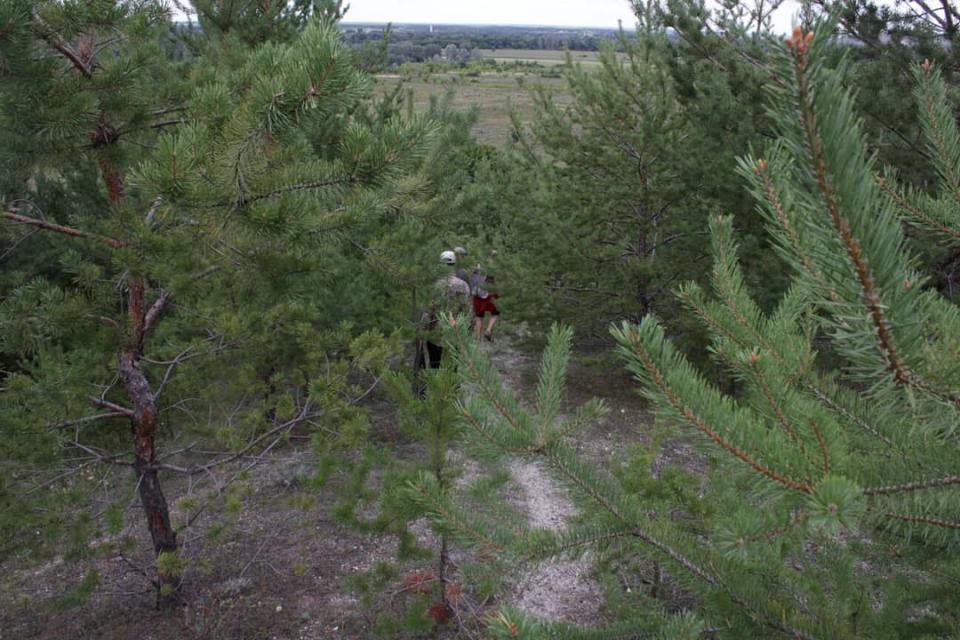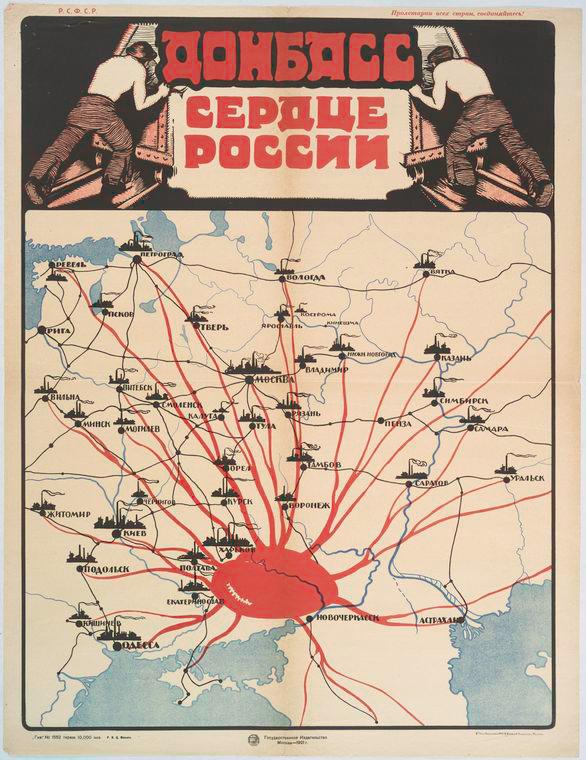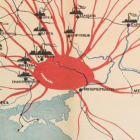
Kreidova flora nature reserve, Donetsk oblast, Ukraine, 2019.
Kreidova flora nature reserve, Donetsk oblast, Ukraine, 2019.
2019 Darya Tsymbalyuk
 This work is licensed under a Creative Commons Attribution 4.0 International License.
This work is licensed under a Creative Commons Attribution 4.0 International License.
What does it mean to be an environmental researcher of Ukraine at the time of Russia’s imperial war on Ukraine? What does it mean to be an environmental scholar when most of the places that you planned to engage with have become inaccessible because of landmines? What does it mean to research environments when entire ecosystems are being erased?
Since 2018, I have been working with the region of Donbas, the stories of migration from the region, and the way multispecies relations have been ruptured by war and displacement. In 2019, I made a trip to the nature reserve Kreidova flora in Donetsk Oblast. The reserve has been home to relict pine trees, Pinus sylvestris var. cretacea Kalenich, a species that has existed since the Cretaceous period. Director of the reserve, Serhyy Lymanskyy, and his team walked my father and me around the site, showing us traces of the military fighting that took place there in 2014.
It is now 2022, and the reserve is again at the epicenter of fighting. Relict pine trees are at risk of being displaced from one of the few places on Earth they can live. Serhyy Lymanskyy is already displaced: his home was destroyed by a tank several months ago. My father has joined the armed forces of Ukraine.
We can only understand the multiplicity of rupture brought by the war and the impact the war has on environments in Ukraine through postcolonial and decolonial lenses. As environmental scholars, we must confront Russian colonial legacy as well as the global petrocapitalism that funds current imperial violence against Ukraine. The region I have been studying, Donbas, has been at the heart of various Russian imperial projects. It is the place where the war started in 2014, and where intense combat is happening now. Studying the environments of Donbas means constantly untangling the logic of Russian imperialism, which operates through military-geologic extractivism. Russia’s war on Ukraine is a form of military-geologic extractivism too, where global petrocapitalism sponsors the war machine, and where the longer history of the region reflects the temporal depth of this violence.

“Donbas is the heart of Russia,” Soviet poster, 1921.
“Donbas is the heart of Russia,” Soviet poster, 1921.
Unknown artist, 1921.
Accessed via Wikimedia on 17 August 2022. Click here to view source.
 This work is licensed under a Creative Commons Public Domain Mark 1.0 License.
This work is licensed under a Creative Commons Public Domain Mark 1.0 License.
Donbas has been colonized through military-scientific expeditions, which provided maps of the lands then called the “Wild Field.” The colonization of Donbas in the seventeenth century coincided with a growing interest in the profit from salt mining, and in later centuries resulted in the involvement of western colonial settlers such as industrialist John Hughes, who founded Hughesivka, known today as Donetsk. The name itself, Donbas, which stands for Donetsk Coal Basin, reflects the colonial logic of perceiving the region only as a resource, forged as a coal- and steel-producing industrial site. Extractivism turns human and nonhuman subjectivities into resources for fueling imperial desires, a process Asia Bazdyrieva calls resourcification, and I call fossilfuelisation. The Soviеt Union continued the colonization of Donbas and other lands through geologic extraction, where geology was closely linked to the military-industrial complex. Soviet modernity began with a geological extraction of resources throughout the empire. A famous Soviet poster states: “Donbas is the heart of Russia.” The image shows a map and the beating heart of Donbas, where the blood (coal) of the region brings life (energy) to other industrial centers. More than one hundred years later, the situation has not changed much, as Donbas continues to be perceived as a resource for fueling Russian imperialism, if not through coal, then ideologically. Fake narratives about the Russian-speaking population in Donbas killed by Ukrainian neo-Nazis served as a justification of the invasion in 2014 and continue to do so today. While coal lost its significance for the fueling of imperial projects, other fossils have replaced it. Oil and gas are converted into the war machine, preserving the mechanism of extractivism, and allowing it to continue the murdering of colonial “others.” Russia’s war on Ukraine erases ecosystems, cities, and factories. The once celebrated industries of Donbas have been damaged or destroyed and mines are flooded. Empires are not static entities—they exist in an ongoing process of consolidation of power and domination. An imperial state such as Russia, formed out of different and diverse cultures, languages, and ecosystems, needs to constantly reinvent itself in order to bring together different parts into one whole, one body. The Soviet Union has done it through imaginings of the proletariat and industrialization in which coal- and steel-producing Donbas was constructed and extracted as the heart of one big body. Current ideology reassembles the imperial body through the idea of russkiy mir, “Russian world,” where the military attempts to incorporate desired parts into a perceived Russian cultural space.
The process of reassembling an imperial body operates by rupturing established relations, including relations across multispecies environments as well as erasing and/or extracting local knowledges of ecosystems. The history of Donbas demonstrates that the ongoing invasion of Ukraine is an intensification of the slower violence of colonialism that has been taking place for centuries through the extraction of fossils, land, and people. In addition to the murder, torture, and rape of people, the Russian military destroys ecosystems that serve as homes for many species, and top layers of the soil, which causes erosion and disrupts the nesting of birds. Russia is also causing chemical pollution through missile attacks and the targeting of industrial infrastructure. More than ever, postcolonial and decolonial environmental scholarship is needed to understand the repercussions of these extractivist forms of violence. By studying the darkness of the Russian imperial core, and the ways in which it has shaped regions, lands, and ecosystems through military-geological entanglements, we can start to understand the extent and depth of the damage done. We can also see the continuing role that fossil-fuel extraction plays in imperial forms of violence everywhere. Therefore, to think about the environments of Ukraine now means addressing petrocapitalist dependencies between Russia and the collective West. Only by disengaging from extractivist practices fueling this war, we can start envisioning ways of recuperating the more-than-human worlds and relations that will survive.
How to cite
Tsymbalyuk, Darya. “What Does It Mean to Study Environments in Ukraine Now?” Environment & Society Portal, Arcadia (Summer 2022), no. 12. Rachel Carson Center for Environment and Society. doi:10.5282/rcc/9494.
ISSN 2199-3408
Environment & Society Portal, Arcadia
 This work is licensed under a Creative Commons Attribution 4.0 International License.
This work is licensed under a Creative Commons Attribution 4.0 International License.
2022 Darya Tsymbalyuk
This refers only to the text and does not include any image rights.
Please click on the images to view their individual rights status.
- Basdyrieva, Asia. “No Milk, No Love.” e-flux journal, no. 127 (May 2022). https://www.e-flux.com/journal/127/465214/no-milk-no-love.
- Basdyrieva, Asia. “Ukraїna i Antropotsen: zemlia” [Ukraine and Anthropocene: land]. Korydor, 18 December 2020. http://www.korydor.in.ua/ua/stories/ukraine-antropocen.html.
- Engelhardt, Anna, and Sasha Shestakova. “Crimean Tatar Infrastructures of Decolonial Care.” European Review 30, no. 4 (August 2022): 532–44. doi:10.1017/S1062798722000199.
- Iakovlenko, Kateryna. “Landscape, Decolonial and Ukrainian Resistance.” blok, 28 March 2022. https://blokmagazine.com/landscape-decolonial-and-ukrainian-resistance.
- Moon, David. The Plough that Broke the Steppes: Agriculture and Environment on Russia’s Grasslands, 1700–1914. Oxford: Oxford University Press, 2013.
- Podov, Vladimir Ivanovich. Istoriia Donbassa: Donbass v XVII–XVIII vekakh [The history of Donbas: Donbas in the seventeenth–eighteenth centuries]. Luhansk: Al’ma mater, 2004.
- Sunderland, Willard. Taming the Wild Field: Colonization and Empire on the Russian Steppe. Ithaca: Cornell University Press, 2004.








